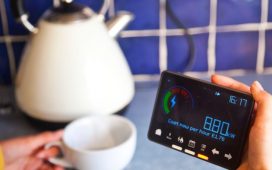Only 1% of British homes have a heat pump, but to hit the government’s climate goals, an estimated 80% of homes should be heated by one in the next 25 years.
Whereas gas boilers burn gas to produce heat, heat pumps do something more complicated. Sometimes described as working like a “fridge in reverse”, they use a mixture of evaporation and condensation to transfer heat from outside to inside a building. In a cold winter, it can be hard to understand how these devices work.
But they do – and here we can see how, by looking more closely at an air source heat pump:
“The key thing to remember is the basic physics of liquids, solids and gases,” says Robert Sansom, who sits on the energy panel of the UK’s Institution of Engineering and Technology.
As with a fridge, a heat pump contains a circuit of pipes containing a material called a refrigerant. The pump uses pressure to force the refrigerant to change state: from a liquid to a gas and back again. And that is what allows the refrigerant to transfer heat energy from one place to another. “As the refrigerant goes from a liquid to a gas, it has to absorb energy from somewhere; and as it goes from gas to liquid, it has to give off that energy.”
Though it can be harder to understand than the combustion that powers a gas boiler, it is a powerful – and efficient – process.
More efficient than gas boilers
Many people are surprised to learn that heat pumps are more efficient than gas boilers. A government-backed study by the research group the Energy Systems Catapult of hundreds of air source heat pumps fitted in UK homes found that heat pumps are about three times more efficient than gas boilers, even on the coldest days of the year.
Marc Brown of the Energy Systems Catapult said: “We can finally put to bed the notion that heat pumps do not work in cold weather conditions and that they are inefficient to run. We’ve observed the exact opposite. They are three times more efficient than gas boilers and work in cold weather conditions. Innovation is changing the game in the heating sector.”
Heat pumps need electricity to run – and the main running cost of the pump is the electricity that powers the compressor. But what allows heat pumps to be so efficient is the process we saw above.
Because they transfer heat from outside, rather than just converting electricity into heat, heat pumps can technically produce more energy than the electricity that is put into them.
Describing this as the “magic” of heat pumps, Sansom explains how heat pumps use “free” energy from outside to hit an energy efficiency of over 100%.
“That’s the magic of heat pumps: you’ve extracted this heat from the environment. [It] could be air source, could be ground source, could be water source, from the sea, even sewage.”
‘Greener’ every year
Heat pumps are considered a crucial plank in Britain’s strategy for dealing with the climate crisis exactly because they run on electricity – which is becoming greener every year.
In 2022, zero-carbon electricity sources – such as renewable energy and nuclear power – made up more than 50% of electricity in February, May, October, November and December. Overall, zero-carbon electricity made up 48% of the UK’s electricity compared with 40% sourced from gas and coal power plants.
The carbon intensity of Britain’s electricity grid is expected to continue to fall as more wind and solar farms are installed and generate a greater share of the UK’s power. By 2035, National Grid aims to operate an entirely net zero electricity grid – meaning households with a heat pump will warm their homes without contributing to the UK’s emissions.
A boost to government grants
Britain’s burgeoning heat pump market has seen a surge in interest since the prime minister promised toincrease the government’s boiler upgrade grants by 50% to £7,500 from November, according to official figures.
Government data shows that the number of households which applied for a new grant climbed to over 2,500 last month, a record high and more than double the number of applications received in the month before.
The scheme, which is available in England and Wales, offers households help to cover the upfront costs of switching from fossil fuel heating systems to a cleaner heat pump alternative.
Still, the number of households interested in replacing their gas boilers with a heat pump remains about 20 times lower than the government’s aim to get 600,000 heat pumps installed each year.
Home heating accounts for almost 40% of the UK’s total gas use, making the government’s heat pump ambition a crucial part of its legally binding target to reduce emissions to net zero across the economy by 2040.
Suitable for most British homes
Some households are concerned that a heat pump may not be able to perform well in their home. Unlike homes in Nordic countries, where heat pumps are commonplace – up to 60% of Norwegian homes are heated by heat pumps – British homes often have poor insulation. Lower levels of insulation can mean the heat pump model – keeping the heating on permanently but at a lower temperature – is less effective.
Experts have called on the government to help households pay for energy efficiency improvements, alongside its heat pump rollout, as part of a coherent home heating strategy.
The good news is that heat pumps can be installed in a wide range of UK homes, according to the Energy Systems Catapult. The first major survey of households who have swapped their gas boiler for a heat pump found that more than 80% were satisfied with the change, and satisfaction levels were similar between respondents who installed a heat pump in a new-build home or in older properties, despite persistent concerns that heat pumps are only effective in modern buildings.










